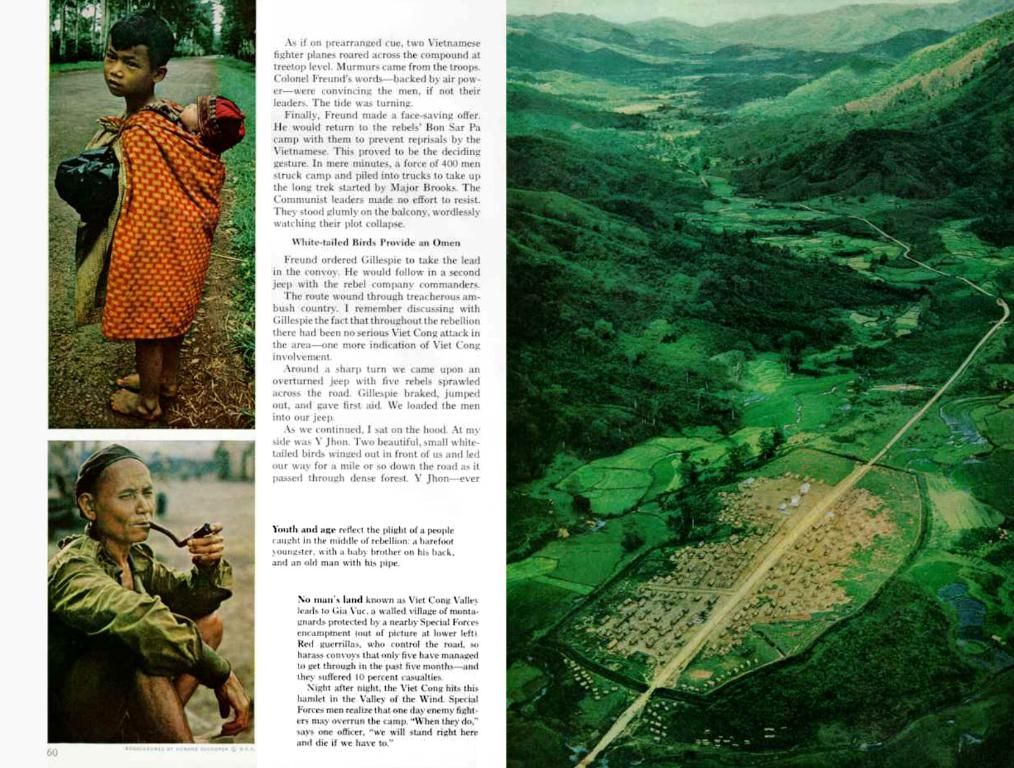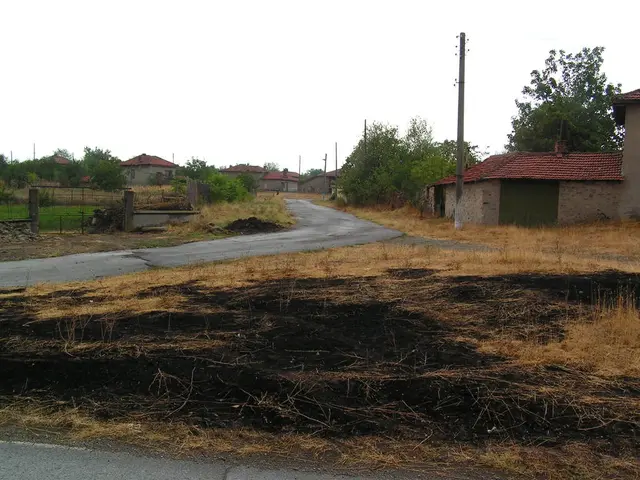Practical Backpacking Tips for Enhancing Your Outdoor Experience, Totaling Over 50 Insights
Are you tired of lugging a 40-pound sack filled with regrets? Sick of soggy socks, bland trail meals, and questioning why your back aches two miles into the journey?
There's got to be a better way!
Well, buckle up, hiking enthusiast — because there is!
These aren't your average "don't forget a water bottle" backpacking tips. These are the real-deal, trail-tested, why-didn't-anyone-tell-me-this-before type of tips!
These backpacking hacks will keep you blister-free, fed, and blissful in the backcountry. Let's dive in!
Planning & Preparation
- Research Permits, Fire Restrictions, and Local Rules: Check if your trail or campsite needs a permit. Some areas have fire bans, group size limits, or camping restrictions that can change by season or weather.
- Test Gear at Home: Test your gear before you even think about hitting the trail. Remember the friend who cut the tags off her brand new boots at the trailhead? She ended up with hotspots before lunch. Save yourself the misery and test everything — from your tent to your sleeping pad — in your backyard.
- Break in Your Shoes Before Your Hike: This one seems obvious, but it's vital — wear in your shoes by taking them on short walks, local trails, or even around the house. If they hurt now, they're going to hurt even more after 20 miles. Don't be that person who suffers because of improper footwear.
- Go on Day Hikes: Do a full pack test before your trip and go on a few short hikes with it. Not only is this great training, but it will also show you if something rubs the wrong way on your backpack. Catch these issues early so you can fix them before you're on the trail.
- Check the Weather: Always check the weather before your trip and pack accordingly. Yes, even if it's always sunny where you live. Mountain weather changes fast, and it's better to be over-prepared.
- Start With an Overnighter: Ease into longer backpacking trips by trying an overnight hike first. This will teach you what you forgot, what you need, and what isn't worth the weight. And if you mess it up, the risk is super low. It's a great training ground for multi-day hikes, too!
- Share the Itinerary: Always create a simple trip itinerary and share it with someone you trust. Include your planned route, campsites, trailhead info, and when you expect to be back. It doesn't have to be fancy or perfect. It just needs to give someone an idea of where you are if something goes wrong. It's a small step that adds a lot of safety.
Gear & Packing
- Focus on the Big Three: Your backpack, shelter, and sleep system are the heaviest items in your pack. Cheap gear might save you money upfront, but it adds weight and wears you down fast. Invest wisely in this gear to feel fewer ounces on your back with each step.
- Pack your Backpack the Right Way: How you pack your backpack matters as much as what you bring. Put heavy items (food bag or cook kit) close to your spine and in the middle of your pack. Put light stuff (like a sleeping bag or jacket) toward the bottom or around the edges. Items you need during the day (rain gear, water) should go near the top or in outer pockets. Don't forget to get a backpack with hip pockets — they're great for snacks!
- Essentials and Multi-Purpose Gear: When every ounce counts, stick to gear that does more than one thing. For example, a foam sit pad can double as a doormat for your tent, and a neck gaiter can look like a pot holder or towel. You don't need a hatchet or extra pairs of underwear for a two-day trip. The lighter your pack, the better you'll move and the more you'll enjoy the hike.
- Layered Clothing Preferred: We don't bring a lot of clothes or "options" — we focus on layers that work together. A sun hoodie, a merino wool base layer, and a rain jacket can handle most conditions. When it's cold, wear them all at once. When it's hot, peel them back. You don't need a separate outfit for every weather change — just smart, lightweight layers that can do the job.
- Cotton is Rotten: Stick to wool or synthetic materials because cotton gets sweaty, soggy, and stinks fast. It doesn't dry well and can chill you quickly. Just say no to cotton.
- One Hiking Outfit, One Camp Outfit: Yes, you can carry more clothes, but you don't need to. One hiking outfit you can dry in the afternoons and one light camp outfit (like shorts and a T-shirt) is enough. Save weight and still stay comfortable, dry, and clean.
On the Trail
- Adjust Your Backpack Straps: Loosen and adjust the straps on your backpack every time you put it on and take it off. This will make a huge difference to both getting your pack on and taking it off, as well as comfort during your hike. Adjust your straps like this:
- Foundation: Hip Belt (over your hip bones)
- Walls: Shoulder Straps (pull these to bring the pack in close)
- Roof: Load Lifters (angle the pack slightly forward)
- Door: Sternum Strap (clip and slightly tighten your chest strap)
- Tip: Re-adjust after 30 minutes. Your pack settles as you walk — take a minute to fine-tune.
- Take Short, Regular Breaks: Short breaks throughout the day make a huge difference in comfort and enjoyment. (We like 5-10 minutes every couple of hours.) Use the time to sip water, eat a snack, or stretch a little.
- Air Out Your Feet at Lunch: Take your socks and shoes off during lunch. Let your feet breathe and dry out. It only takes a few minutes, but it helps prevent blisters and keeps your skin healthy.
- Treat Hot Spots Immediately: Treat hot spots as soon as you feel them to prevent blisters from getting worse. If you stop, take off your shoes and socks, let your feet breathe, and apply something like RockTape or Leukotape to the spot. Sit, eat a snack, drink some water. A few minutes now can save you hours of pain later.
- Drink and Eat Whenever You Want: You're probably not eating enough, so snack whenever you're hungry. Carry snacks in your hip pockets for easy access. Fueling properly is like flipping a switch. When your body has the fuel it needs, everything just works better.
Campsite & Leave No Trace
- Camp 200 feet from water: Listen up, river lovers! Camp at least 200 feet from water, and keep all trash and waste away from it. Clean water depends on us doing the right thing.
- Follow local camping rules: These go back to planning your trip so you actually know the rules. Don't be that person ignoring signs or skipping the bear can. Camp where you're supposed to, carry what's required. It's not about checking boxes — it's about protecting the places we're lucky to explore.
- Store food in bear-safe containers: Follow local regulations — some places require a hard-sided bear canister, others allow a proper food hang. Either way, don't just think about food. Anything scented needs to be stored as well (think chapstick, deodorant, toothpaste, too). Bears have an incredible sense of smell, and it's not worth the risk.
- Cook and Eat Away From Your Tent: Cook and eat at least 100 feet from where you sleep. You're not just keeping yourself safe — you're setting yourself up for a better night's sleep. It's one of the easiest ways to keep bears and sneaky critters out of camp. And trust us, everything sounds bigger at night.
- Pack Out All Your Trash: Pack out all your trash — every wrapper, crumb, and used wipe. These places stay wild and beautiful only if we take care of them. Leaving trash behind doesn't just look bad — it harms wildlife and disrespects the land. If you're not willing to pack it out, maybe these places aren't for you. Respect the trail, and leave it better than you found it.
Navigation & Safety
- Download Offline GPS Maps Before Your Trip: Always download offline GPS maps before your trip. You can be sure that you probably won't have service in the backcountry. Our favorite tool for this is onX Backcountry. It's reliable, easy to use, and lets us build our own routes. Get detailed topo maps, public land info, and offline access without the clutter.
- Consider a GPS Communicator or Satellite Device: Your phone can do a lot, but a GPS communicator does more, especially when things go wrong. Devices like the Garmin InReach give you an SOS button for true emergencies, weather updates in the backcountry, and two-way messaging when there's no cell service. We bring ours on every trip. It's not something we use often, but just knowing it's there gives us extra peace of mind.
- Carry a Map and Compass: Always carry a paper map and compass, and know how to use them. Electronics fail. Apps crash. A paper map and compass weigh almost nothing but could save your life when tech lets you down. Don't just toss them in your pack and forget them. Practice ahead of time so you're ready when it counts. Reliable navigation isn't optional in the backcountry — it's part of staying safe.
- Bring a Power Bank for Electronics: We always carry a power bank on every trip. Phones handle our maps, notes, photos, and emergency contact, so staying charged matters. Cold temps and long days kill batteries fast. A small power bank gives us a few full charges and keeps things running all trip long.
- Stay on Marked Trails: Staying on marked trails is one of the simplest ways to avoid getting lost, or at least less lost than if you wandered off trail. But it's not just safety, It's also about preserving fragile plants and ecosystems. Every off-trail shortcut leaves a mark. Stick to the path and help protect the places we're out here to enjoy.
- If Lost, Stay Calm and Retrace Steps: What not to do: Stay calm. Everybody STAY CALM!! I'm not freaking out, you're freaking out. It's not even that big of a deal if you've been staying on trail. Just turn around and hike back the way you came until you find where you got off track. Off trail? That's where things get trickier. Stay calm. Look at the terrain, notice landmarks, and retrace your steps. Watch for signs like trampled grass, broken branches, or worn paths. Take your time and think it through. Simple, right? (or just pull out a GPS)
- Carry a Complete First-Aid Kit: We carry the HART Day Hike kit. It's light, compact, and has everything you really need. It's easy to toss in your pack and forget about until you actually need it. Just add RockTape or moleskin for blister care, and you're set. Small kit, big peace of mind.
- Don't Approach or Feed Animals: I shouldn't have to say this, but don't feed the wildlife. Squirrels, chipmunks, and deer don't need your trail mix. In fact, feeding them can mess up their natural behavior and diet. Even the salt from your snacks can ruin seed stores that small animals rely on to survive the winter. They don't know better, but you do. Keep your food to yourself and protect the animals that can't protect themselves.
Let's conquer the trail together, one hiking step at a time! Happy adventuring!
- Be aware of medical-conditions and chronic-diseases: Check with your doctor before embarking on any hiking or camping trips, especially if you have a history of heart disease, diabetes, or other chronic illnesses. Carry any necessary medication and consult with a medical professional about managing your condition while on the trail.
- Prepare for cancer treatments: If you are currently undergoing cancer treatments, speak with your healthcare provider about any accommodations that may be necessary during your hiking trip. Think about potential challenges such as fatigue, sensitivity to sunlight, or changes in appetite.
- Improve overall health and wellness: Engage in regular fitness-and-exercise routines to prepare for your hiking adventure and improve your overall health and well-being. This can help reduce the risk of developing chronic diseases and ensure that you feel open to enjoying the trails.
- Prioritize mental-health: Remember to prioritize your mental health while hiking. Practice mindfulness, meditation, or yoga to help alleviate stress and anxiety during your trip. Share your concerns with loved ones back home and consider speaking to a mental-health professional if needed.
- Focus on men's health: Encourage men to focus on maintaining their health through regular check-ups, skin-care routines, and therapies-and-treatments for common concerns like prostate health or hair loss.
- Understand women's health: Women should be aware of the unique health concerns they may face while hiking, such as menstrual cycles, menopause, or sexual-health issues. Be prepared with the necessary supplies and medications, and seek help from a healthcare provider if needed.
- Prioritize family health: Hiking as a family can be a wonderful bonding experience, but be aware of the health needs of all family members. This may include addressing children's concern about hiking and camping safety, as well as accommodating the needs of elderly or disabled family members.
- Acknowledge climate-change: Be aware of the impact climate change may have on hiking trails and consider taking steps to minimize your carbon footprint during your trip. This may include using environmentally-friendly transportation and reducing waste while on the trail.
- Support environmental-science: Educate yourself on environmental-science issues and how they affect hiking trails, wildlife, and the overall ecosystem. Consider making eco-friendly choices, such as using biodegradable soap or choosing a tent that is made from sustainable materials.
- Embrace a lifestyle of health and fitness: Adopt a healthy lifestyle that includes regular exercise, eating nutritious foods, and practicing good self-care to ensure that you are able to enjoy hiking and other outdoor activities for years to come.
- Maintain home-and-garden: Keep your living space organized and clean to reduce stress and create an environment that supports a healthy lifestyle. Gardening can be a great way to engage in physical activity and connect with nature.
- Drive eco-friendly vehicles: Consider purchasing an electric-vehicle or car that is fuel-efficient to help reduce your carbon footprint and promote a cleaner, healthier planet.
- Follow sports-leagues: Stay up-to-date on sports-leagues, including football and European leagues, to learn about impressive feats of physical fitness and take inspiration for your own hiking journey.
- Advocate for men's health: Support organizations that focus on men's health issues, including prostate cancer research, testicular cancer awareness, and mental-health initiatives for men.
- Demand women's health-care: Advocate for policies and funding that support women's health-care, including access to contraception, family planning, and reproductive-health services.
- Promote good parenting: Share advice and resources on parenting, including strategies for instilling good health habits in children and setting a positive example for them to follow. Encourage parents to take their children on hiking trips and other outdoor adventures to foster a love for nature and promote lifelong health and wellness.








